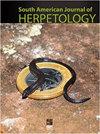Trade-Offs between Ecomorphology and Autoecology Enable the Coexistence of Tree Frogs (Hylidae: Boana spp.) during the Dry Season in an Atlantic Forest Area of Northeastern Brazil
IF 0.7
4区 生物学
Q4 ZOOLOGY
引用次数: 0
Abstract
Abstract. Competition can generate different ecomorphological patterns resulting in trade-offs, considering that certain resources are better used than others. We investigated how three species of Boana share resources in Serra de Itabaiana National Park and how morphology and environment cause trade-offs in interactions. We hypothesized that the large body size of B. faber might favor coexistence, allowing niche segregation with the other, smaller species B. albomarginata and B. pombali. Data collection occurred in the dry season of 2019 through active search at 18:00–22:00. We obtained microhabitat data for the species, recorded morphometric measurements, and analyzed gastrointestinal contents. There is evidence of resource partitioning in vertical space, as the large species occurs at ground level while the smaller congeners are found on higher perches. We hypothesize that lower sites can better support the large B. faber at our study site. There are no differences in the trophic niche, as prey volumes did not differ among the three species. Nevertheless, the size factor rendered low niche overlaps between B. faber and B. albomarginata, which are the phylogenetically closest species. Moreover, the species consumed typical prey of certain height ranges and accessed different items with high energy or hydric value. We believe that the sampling period performed in the dry season provides important trade-offs between the species studied with body size and ecological factors being crucial in this.生态形态学和自身生态学之间的权衡使巴西东北部大西洋林区的树蛙(Hylidae:Boana spp.)在旱季共存
摘要考虑到某些资源比其他资源得到更好的利用,竞争可以产生不同的生态形态模式,从而产生权衡。我们调查了三种Boana如何在Serra de Itabaiana国家公园共享资源,以及形态和环境如何导致相互作用的权衡。我们假设,B.faber的大体型可能有利于共存,允许与其他较小的物种B.albomarginata和B.pombali进行生态位分离。通过18:00-22:00的主动搜索,数据采集发生在2019年旱季。我们获得了该物种的微生境数据,记录了形态计量学测量结果,并分析了胃肠道内容物。有证据表明,垂直空间中存在资源分配,因为大型物种出现在地面,而小型同类则出现在较高的栖息处。我们假设较低的位点可以更好地支持我们研究位点的大型B.faber。营养生态位没有差异,因为三个物种之间的猎物数量没有差异。然而,大小因素导致B.faber和B.albomarginata之间的生态位重叠较低,这两个物种是系统发育上最接近的物种。此外,该物种消耗了特定高度范围的典型猎物,并获得了具有高能量或高氢能价值的不同物品。我们认为,在旱季进行的采样期为所研究的物种之间提供了重要的权衡,其中体型和生态因素至关重要。
本文章由计算机程序翻译,如有差异,请以英文原文为准。
求助全文
约1分钟内获得全文
求助全文
来源期刊
CiteScore
1.50
自引率
0.00%
发文量
10
期刊介绍:
The South American Journal of Herpetology (SAJH) is an international journal published by the Brazilian Society of Herpetology that aims to provide an effective medium of communication for the international herpetological community. SAJH publishes peer-reviewed original contributions on all subjects related to the biology of amphibians and reptiles, including descriptive, comparative, inferential, and experimental studies and taxa from anywhere in the world, as well as theoretical studies that explore principles and methods.

 求助内容:
求助内容: 应助结果提醒方式:
应助结果提醒方式:


